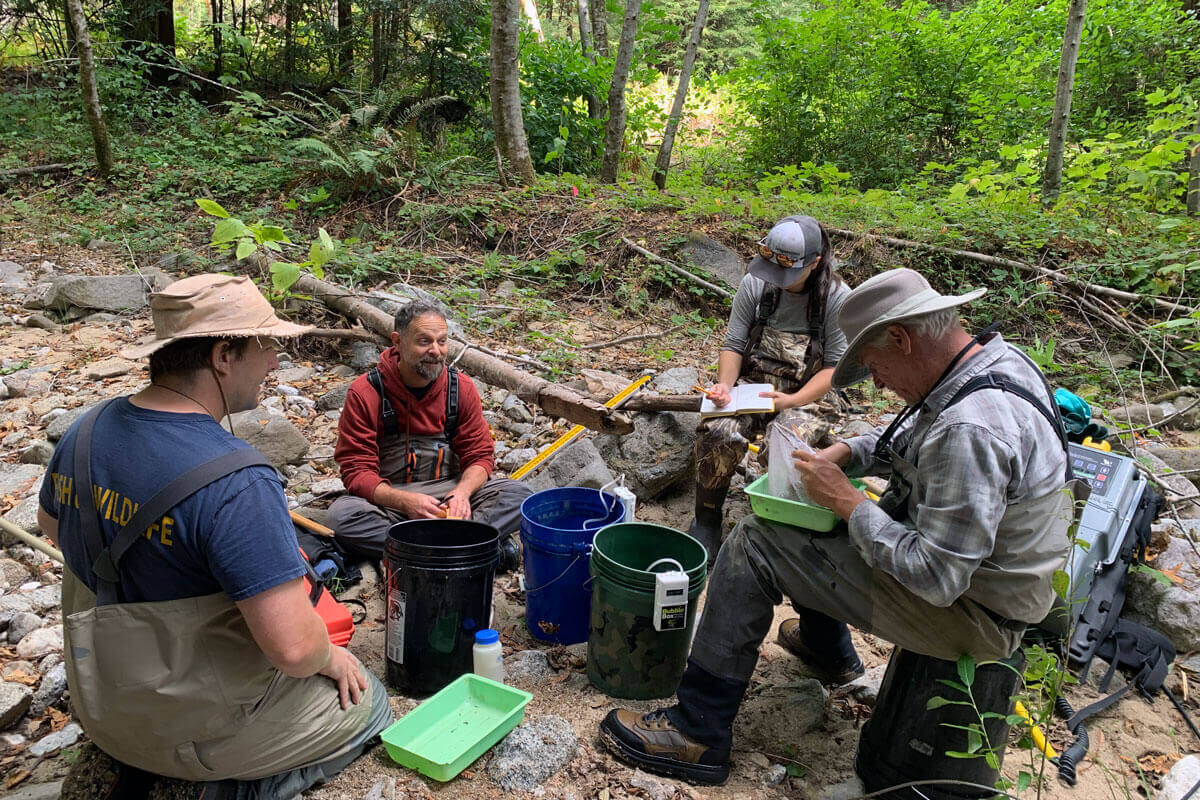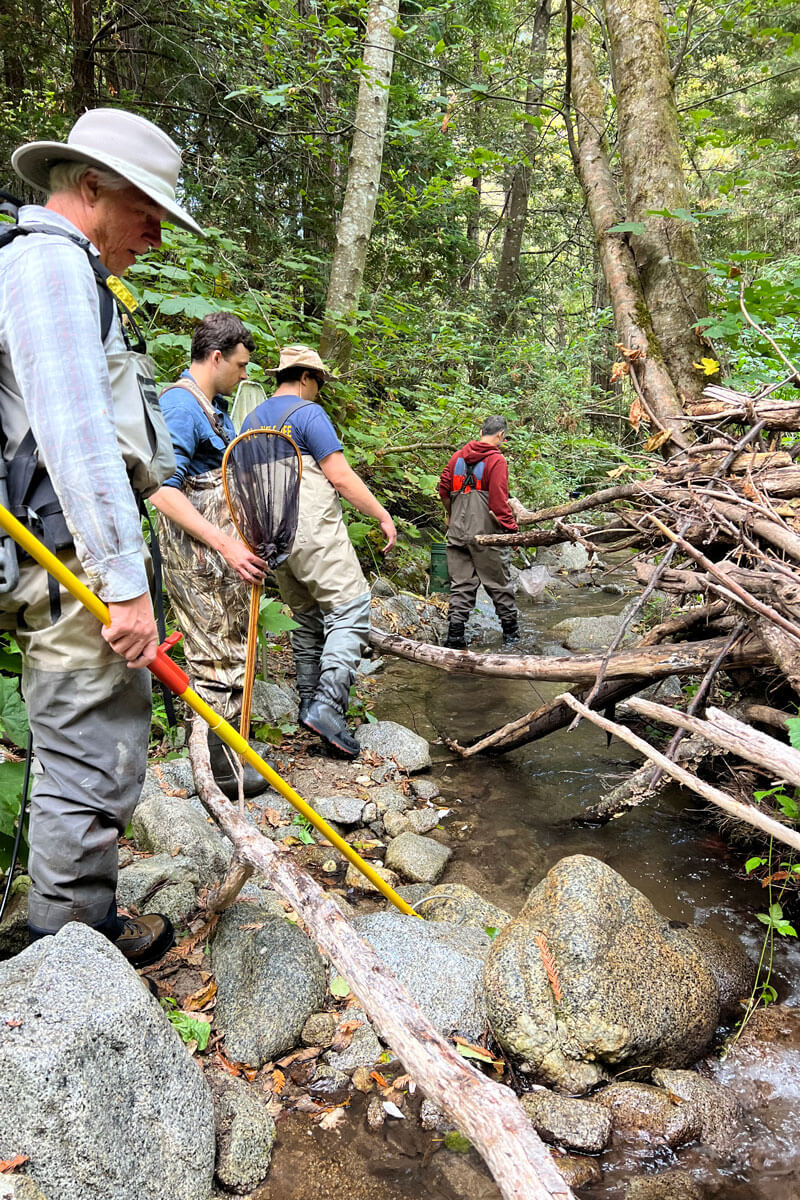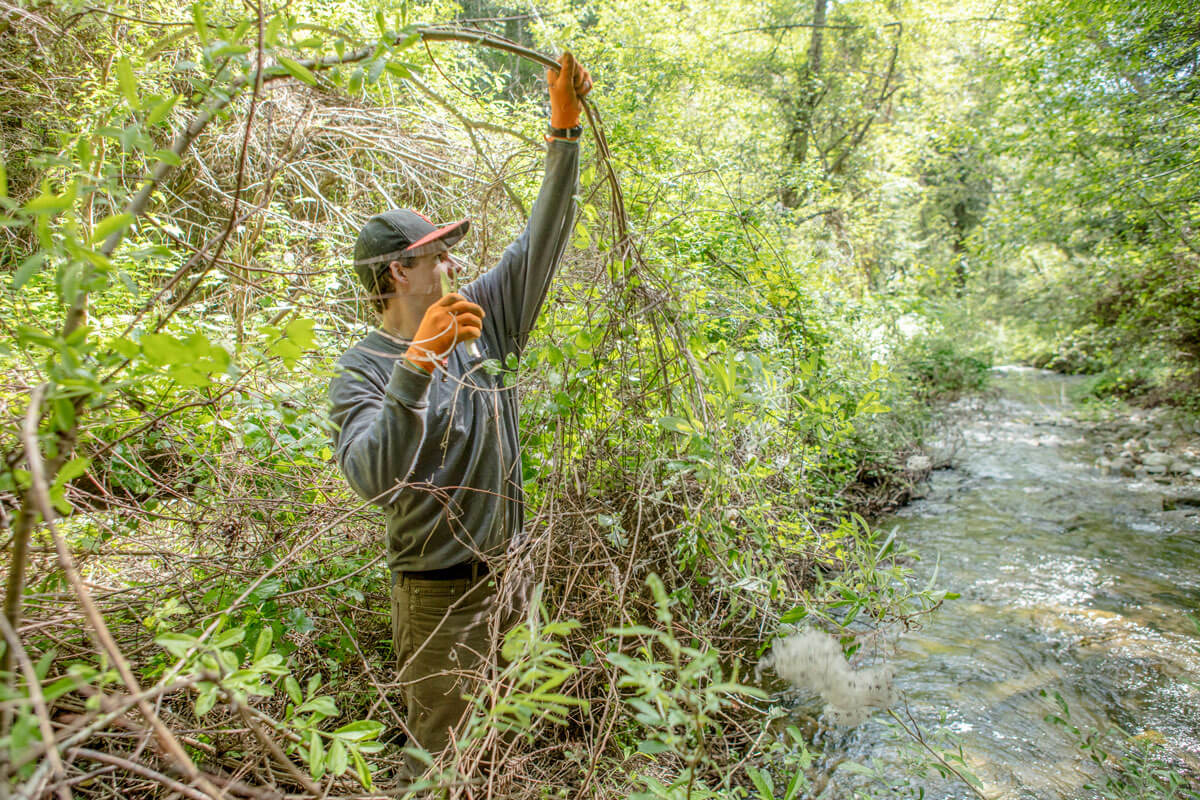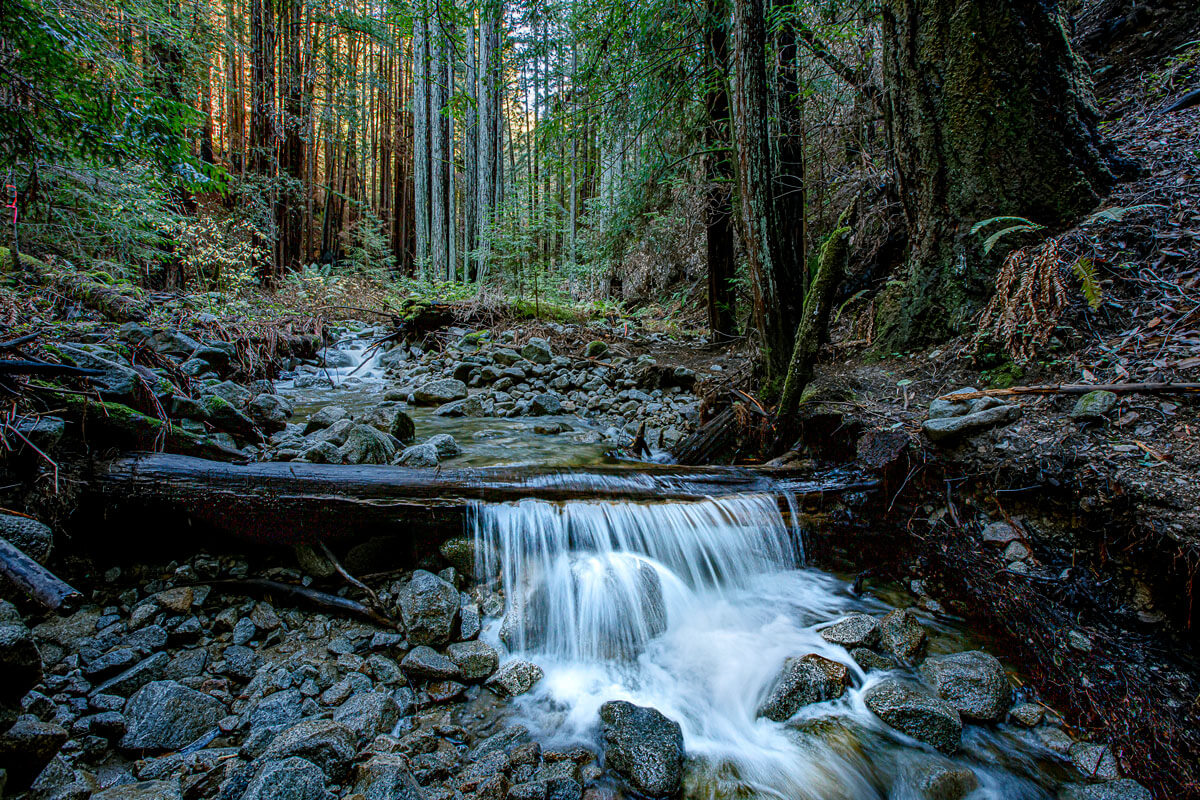Coho, Cobble, and Creek Beds: A Year After the Mill Creek Dam Was Removed
video by Ian Rowbotham.
The Dam’s Damage
Mill Creek dam was on just one of eight streams crossing San Vicente Redwoods’ 8,532-acres, a conservation property owned by Sempervirens Fund and Peninsula Open Space Trust, and managed in partnership with Save the Redwoods League and Land Trust of Santa Cruz County. But amidst the vast partners' visionary conservation and restoration plans, removing the defunct, never-operational dam and restoring the San Vicente watershed have been high priority projects for a decade.
Mill Creek is part of an exceptional regional creek system with drought-resistant, cool, heavy flows directly into the Pacific ocean that are accessible for anadromous fish like endangered coho salmon and threatened steelhead trout that travel from the ocean to freshwater inland to spawn. However, for more than 100 years, Mill Creek dam blocked both fish from traveling upstream and the cobble they require for their spawning habitat from traveling downstream.
With no benefit to the dam’s existence and great impact upon the watershed and its inhabitants, it was clear the dam should be removed. But navigating the approval process necessary to do so was not as cut and dry. So, while awaiting the approval process to remove the dam, Sempervirens Fund’s Land Team and partners began to prepare for the dam’s eventual extraction.
Preparation and Restoration
Over a decade, culverts and roads were improved to reduce erosion downstream, the stranglehold of invasive plants like Clematis vitalba were removed from alongside–and even underneath–the creek, the creek’s natural floodplains were replanted with native plants, and large woody debris have been placed in the creek to mimic natural conditions like those needed to trap sediment for steelhead trout and coho salmon spawning grounds. The impacts of these restoration activities on the watershed’s health and salmonid habitat were monitored utilizing techniques like environmental DNA (eDNA) sampling which also helped to provide a snapshot of the existing fish communities above and below the dam before it was removed. Watch the video to learn more about eDNA sampling.
Down Comes the Dam
Finally, after a century of standing in the way and a decade of planning, restoration projects, and monitoring, the dam’s removal was officially approved.
Watch as ecologists unlock the granite and cobble from behind the dam and reshape the creek bed just weeks before multiple storms flush the cobble downstream and crucial sandbar habitat begins to form at the confluence of Mill Creek and San Vicente Creek. Then, scroll down for the big reveal: exciting findings and what’s next.
Releasing Mill Creek in Timelapse
Creek Beds and Spawning Beds
After the winter storms in 2021 began to move the recently freed granite, cobble, sand, and sediment downstream along the creek bed, sandbars–ideal for salmonids like steelhead and coho to lay their eggs– began to form. By March 2022, Senior Land Stewardship Manager Ian Rowbotham was out with aquatic ecologists assessing the spawning bed downstream from the former dam site who saw all the great signs of “quality gravel beds”. “Sediment has accumulated in key places and formed into potential spawning beds that might be used this winter,” Rowbotham said. Just a few months later, there were even more exciting signs.
Finding Fish
In September, Rowbotham and Field Operations Manager Melisa Cambron Perez headed back to Mill Creek in hopes of finding fish. They were joined by Aquatic Ecologist Mike Podlech, Ecologist Jim Robins, and California Department of Fish and Wildlife Biologist Sean Cochran–who attended on the slight chance a federally endangered coho salmon was found. “We didn’t expect to see any coho in Mill Creek,” Rowbotham said. “They had never been documented there before.”
Coho in the Creek
Podlech donned a Ghostbustersesque e-fishing backpack calibrated to Mill Creek’s current conditions to painlessly stun the fish for quick, careful species identification and measurement recording before they are promptly returned to the creek. Thankfully Cochran was in attendance, because the very first fish found was a federally endangered coho salmon. To the knowledge of all scientists present, this was the first ever record of a coho salmon in Mill Creek.
Without a representative from the California Department of Fish and Wildlife, handling a federally endangered species like a coho salmon would not have been allowed. Since our California Department of Fish and Wildlife Biologist was present, it was possible to take coho fin clip samples for DNA and genetic testing that can determine down to a family level where the coho came from–providing a better understanding of this species’ migration and this exciting sighting.
Across three sampling sites on Mill Creek, 15 juvenile coho salmon were recorded downstream from the former dam location. Podlech pointed out that although we do not have evidence that the coho are present in Mill Creek as a direct result of the dam removal, coho salmon are a relatively reliable indicator of good stream conditions. “It is reassuring to know that the dam removal project has opened access to additional habitat should the species expand its range upstream in Mill Creek in the future,” Podlech said.

photo by Ian Rownotham
Steelhead Up The Stream
While the coho salmon were all spotted downstream, steelhead trout had already made their way upstream from the dam site for the first time in 100 years. Twelve juvenile steelhead trout were found across the three sampling sites on Mill Creek. Although it was unexpected to have found any coho salmon in Mill Creek at all, it was especially surprising that fewer steelhead trout, a threatened species, had been found compared to coho salmon, an endangered species. Podlech explained how the timing of the rains over the last year may have made access to and availability of spawning grounds more advantageous to coho salmon and less water more challenging for steelhead trout:
photo by Ian Rowbotham.
Storms, Steelhead, and Other Signs of Success
The hope had certainly been, if we unbuilt it, they would come, but it was anticipated it could take years for the conditions and salmonids to return after the dam’s removal. In less than a year, potential spawning habitat has formed, steelhead trout have been witnessed above the former dam site, and the first documentation of endangered coho salmon–the very species we hoped most to support with the dam’s removal–in Mill Creek has occurred. While there was much research, planning, and work on our end, and an Amah Mutsun Tribal Band ceremony to “welcome back” the salmon, nature came through in a big way too. So, to what do Rowbotham and Perez attribute this early success?
1. The Amount of Sediment Movement
Earlier projects to restore natural conditions to Mill Creek downstream from the dam were instrumental in preparing the creek bed for the cobble and sediment to come. Large Woody Debris (LWD)—trees and branches that fall into the water—are common in forested waterways but over the last 150 years people saw them as obstructions to moving logged trees out of the forest, moving boats and logs down the water, to their views, and as the causes of potential floods, and removed them.
Interestingly, one of the LWD sites that was specifically installed to restore the creek’s natural floodplain was instrumental in recreating prospective salmonid spawning habitat, because today we know how crucial LWD is for many of the forest’s inhabitants. The LWD was placed to shift Mill Creek back across its former flood plain, where water can typically spread wider and shallower, giving the fish access to more food and spawning beds.
But the LWD was like a great catcher receiving a stellar pitch. The historic storm just two weeks after the dam was removed increased Mill Creek’s flows enough to move the granite, cobble, and sediment built up over 100 years down the stream to collect around the LWD much faster than the several years that had been expected. Although monitoring will continue, conditions indicate the potential for spawning beds will continue to improve without further intervention.

photo by Melisa Cambron Perez.
2. No More Barriers
The dam on Mill Creek at 12 feet high and 25 feet wide was a large and obvious obstruction for water, cobble, sediment, and fish alike. Its removal added another half mile of free flow to Mill Creek. But after it joins with San Vicente Creek it continues its journey all the way out to the Pacific ocean, and even though its lack of estuary makes being stopped by a sandbar less likely, other barriers for fish passage could occur along the way. However, the first documented appearance of coho salmon downstream in Mill Creek and steelhead trout upstream from the former dam site for the first time in 100 years indicate the waterway for their migration is passable for the time being.
3. Nothing Went Wrong with Downstream Infrastructure
While the Mill Creek dam that was removed was defunct, Mill Creek still provides a secondary source of water to the nearby town of Davenport. The water lines that used to run across the top of the defunct dam were damaged in the 2020 CZU Fire but new water lines were re-routed and installed. Fortunately, since the dam’s removal and the historic storm that quickly followed, important infrastructure on Mill Creek, like Davenport’s waterline, has continued to function properly so the creek’s improved flow and water quality benefit people and fish alike.

photo by Ian Bornarth.
Around the Bend
In the creek itself, Rowbotham and Perez say adding more LWD to strategic locations will create more shelter, pools, spawning grounds, winter refuge, and food sources for fish.
Perhaps most importantly, with so many potential factors in the ecosystem that can cause the fish populations to change in Mill Creek, like the amount and timing of rain as Podlech mentioned, continuing to collaborate on surveys with our partners like the Amah Mutsun Land Trust, University of California Los Angeles, and San Jose State University is crucial to ensuring Mill Creek endangered species like coho salmon are supported with a healthy habitat.
Ideally, the first documentation of coho salmon in Mill Creek will generate more interest and funding to continue geomorphic and eDNA research in addition to new regular fish surveys to monitor Mill Creek’s fish community to ensure this newly restored habitat for a federally endangered species can continue to improve and thrive. However, if Mill Creek can sustain an endangered species–which are often sensitive to change–like a coho salmon, it is likely a healthy habitat from which many other plant and wildlife species in the redwood forest and beyond will benefit from as well.
We hope this is the beginning of many more exciting signs of health and healing thanks to the support of more than a decade of conservation and restoration efforts in San Vicente Redwoods.

photo by Ian Bornarth.
In September 2023, less than two year's after the removal of the defunct dam on Mill Creek in San Vicenete Redwoods, more threatened steelead trout fry were spotted in Mill Creek during ongoing salmonid surveys. Among them was a larger steelhead trout juvenile thought to be a second year juvenile—or smolt—that may have lived in Mill Creek since the dam's removal. Jim, an ecologist with Resource Conservation District, noted the variety in size of the steelhead in the system may be the result of a longer spawning season. You can watch the steelhead's release back into Mill Creek after they were carefully recorded by our team of aquatic biologists and researchers.
video by Christopher Lopez
You can read the full story behind this great work that you've made possible – including the first ever recording of an endangered coho salmon in Mill Creek – above. We’ll be sure to share more exciting findings from our ongoing salmonid surveys and the eDNA research of our partners at UCLA and Amah Mutsun Land Trust.
More to Explore
- Read more about the Mill Creek Dam and San Vicente Watershed
- Read more about removing the Mill Creek Dam with San Vicente Creek: Restoring a Stronghold
- To learn more about what the dam’s removal means for the watershed and coho salmon, watch Restoration of Mill Creek

